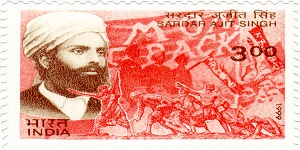The revolutionary movement was a movement that believed in using physical, economic, and diplomatic means to ensure India’s freedom.
Thousands of Indians gave up their lives, liberty, and property to fight for India’s freedom.
Many of them worked from Europe and other foreign countries. This ensured that freedom fighters who were being hounded in India had a place to go to, and also ensured diplomatic international pressure on Britain to free India. Let’s meet some of these heroes.
Who were these heroes?
VOC or VO Chidambaram Pillai
VOC was a brilliant barrister in Chennai.

He founded India’s first shipping company – Swadeshi Steam Navigation Company, way back in 1906.
This company offered steamer journeys from Tuticorin to Colombo at a fraction of the price of the British vessels. This threatened the British shipping industry so much that they first reduced prices, then even offered free passage.
He was then hounded by the British, who arrested him in 1908 for his political activities and sentenced him to life – 40 years. In jail, he was not treated as a political prisoner, but a criminal. The hard labour led to a fall in his health and he was released from jail on health grounds.
There is much more to his life and sacrifice.
Madam Cama

In 1907, the International Socialist Conference was being held at Stuttgart in Germany. An Indian Parsi lady came to the stage and unfurled Independent India’s national flag. She had designed and made the flag herself.
After that, she ensured that the national flag of India was hoisted wherever she held a meeting.
Born to a rich Parsi family of Mumbai, Madame Cama devoted her life, health, and money to the Indian freedom movement.
She was a key campaigner for Dadabhai Naoroji when he was elected to the British parliament – becoming the first Indian ever to hold that distinction.
This is the
Lala Hardayal

A simple journal called “Gadar” – published in all major Indian languages and secretly distributed to Indians and sympathisers of the cause of Indian Freedom – later lent its name to the political party – Gadar Party – Lala Hardayal was the founder and the first editor of that journal.
An exceptional student who studied at St. Stephens, Delhi, and got a scholarship to Oxford University, London. Not just that, he also ensured that his wife studied at Oxford alongside him – a rare thing in those times.
Madanlal Dhingra

Anyone who has casually studied the revolutionary freedom movement of India would have heard the names of Lala Lajpat Rai and Shri Madanlal Dhingra.
He was the son of a father who was a government servant in India and sent Madanlal ji to England for his higher studies. But Madanlal was cut from a different cloth. In India House (London), he expressed his desire to free India.
He expressed to the British that just as the British feel that Germany has no right to rule them, the Indians also reject British rule.
Rash Behari Bose

Rash Behari Bose is best known as the founder of the Indian National Army. The Indian National Army was started by convincing the Japanese to release Indian prisoners of war (PoW) so that they may fight for India’s freedom. This was perhaps one of the earliest victories of diplomacy.
Captain Mohan Singh and Rash Behari Bose worked tirelessly to further the Indian cause.
Subhashchandra Bose later took over the INA and guided it to its future success.
Maulvi Barkatulla

In December 1915, an interim government of free India was set up in Kabul under the leadership of Raja Mahendrapratap. The prime minister of that government was Maulvi Barkatulla.
Alongwith Raja Mahendra Pratap and other socialists, he met Lenin to further the cause of socialism in India. He also lived in Japan, Germany, and Russia for extended periods of time and supported the Indian freedom movement from there.
Sohanlal Pathak

As a young man, he was very influenced by the ideals of Lala Lajpat Rai. He inspired troops in Singapore, Myanmar, and Malaysia. In his leadership, 2000 soldiers of Singapore resisted the British. For three days – 14, 15, 16 March, 1915, the uprising freed Singapore. It remained free of British rule for 15 days, before being recaptured by the British.
He was later arrested by the British in Mayanmar (then part of India’s territory) and was jailed in Mandalay Fort.
Shyamji Krishna Verma

He was one of the founders of the famous India House in London and the India Home Rule Society (a group that believed in India’s autonomy within the overall British commonwealth). India House was a hostel in London for Indians of limited means who were coming to London to study. Later, India house provided the incubation needed for the Indian freedom movement in London. It also became the place were Indian, Irish, and other freedom fighters met to join hands, share information, and collaborate.
He was also a scholar of Sanskrit, and the Dewan of Ratlam and Junagarh (Junagarh was one of the richest princely states of India).
Sufi Amba Prasad

He was born in Moradabad, India, in 1858. His right hand was missing from birth. He used to joke that he lost his right hand in fighting the British in 1857, so when he was reincarnated in 1858, it was without that right hand.
He was a scholar of Urdu and Persian. For his writing, his entire property was confiscated and he was kept in prison under harsh conditions for six years.
After the British government hounded him out of India, he went to Nepal and then to Iran, where he worked for both Iranian and Indian independence. He became a very popular figure in Iran.
The epithet “Sufi” was given to him by Iranians.


One Reply to “India’s Lesser-Known Freedom Fighters”
Comments are closed.